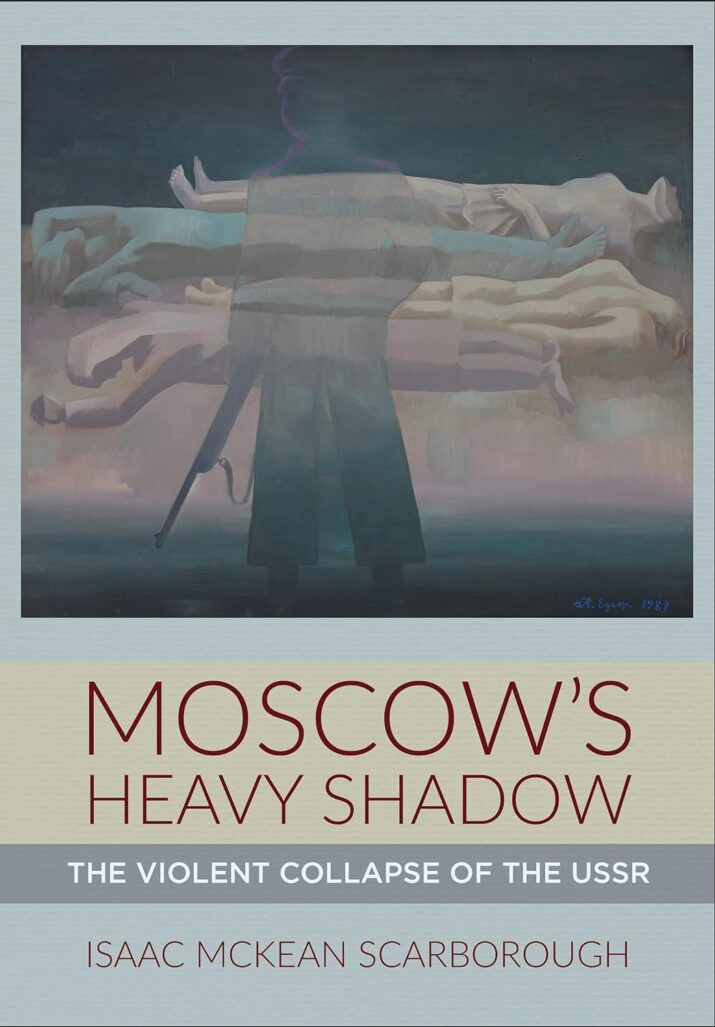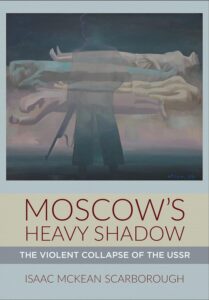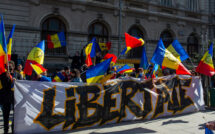

Isaac McKean Scarborough’s Moscow’s Heavy Shadow: The Violent Collapse of the USSR is a tremendously important book. Its focus on the economic history of the late Soviet period in Central Asia—specifically in Tajikistan’s capital city of Dushanbe—fills myriad lacunae and makes it the first book on the Gorbachev era in Soviet Central Asia, contributing to the fields of Soviet history, Central Asian history, and broader economic history. Moscow’s Heavy Shadow is lucidly and engagingly written, with short, exciting chapters that almost make it into a novel. No less importantly, Scarborough relies on an impressive variety of sources in both Tajik and Russian, ranging from documents in the George H.W. Bush Presidential Library to files at the Central State Archive of Tajikistan, to which it is notoriously difficult to gain access. Scarborough also conducts oral history interviews with witnesses of the collapse of the Tajik Soviet Socialist Republic and subsequent civil war.
Scarborough’s argument is very clear: “reforms to the Soviet Union’s economic and political system undermined Tajikistan’s previous stability, enervated a new class of populist politicians, and led to the outbreak of civil war in 1992” (3). Through this argument, he fundamentally links the policies of glasnost and perestroika to the USSR’s collapse and the violence that followed and places Tajikistan’s civil war in a broader context of late- and post-Soviet violence, ranging from Nagorno-Karabakh to the Moscow gangs of the 1990s. This approach situates Scarborough’s book nicely as a successor to Mark Beissinger’s (2002) classic book, Nationalist Mobilization and the Collapse of the Soviet State, which examines the violence of the late Soviet period but does not consider non-nationalist violence or follow any of it into the post-Soviet period. In broader terms, then, Scarborough examines the intersection between economic collapse, destabilization, and violence in Tajikistan both during and after the Soviet period.
The book follows the simultaneous collapse of the Soviet Tajik economy and growing violence in Tajik society, which goes from relative calm to the February 1990 protests in Dushanbe, during which tens of thousands publicly protested against the leadership of the republic’s Communist Party. Scarborough argues that nationalism was not the reason behind these protests—contemporary sociological research had established that there were relatively low levels of nationalist sentiment in the republic—nor was the violence due to glasnost-era political mobilization. These protests were, rather, “a largely undirected explosion of frustration against political leaders who were seen as no longer guaranteeing the basic social functions that the Soviet system had long provided” (98). Though the city quickly returned to its normal life, the cost of living was still increasing as a result of Gorbachev’s economic reforms. Moreover, the social fabric of the city continued to disintegrate as the number of outlets for discontent,—such as newspapers and opposition parties—grew as a result of Gorbachev’s new social policies. This dissatisfaction would again turn violent, eventually culminating in the country’s 1992-97 civil war.
Throughout Scarborough’s narrative, Tajikistan remains tethered to Moscow. Not even opposition leaders had actionable ideas of disentangling themselves from it, exacerbating their inability to address problems in the republic itself. Even after September 9, 1991, when Tajikistan became de facto independent, the government had little idea of what to do. It could not even afford, as Scarborough demonstrates, to buy new buses or spare parts for old ones. Thanks to Gorbachev’s reforms encouraging private enterprise, “private businesses,” the author notes, “were starving the budget,” and the government simply did not have the funds to provide basic goods such as foodstuffs (135).
By the time the Soviet Union collapsed, “Tajikistan’s government [had] lost control of its people and territory… because… there were basically no spoils left to divide” due to “economic collapse… low-level theft, [and] embezzlement” (141). Scarborough notes that this was not inevitable; rather, it was the decisions of individual politicians that plunged society into chaos and led it into the hands of populist politicians, dividing and leading it into civil war. Scarborough argues that the violence in Tajikistan “was not an exception” and that “war, violence, and death followed the collapse of the USSR across its territory” (171). Indeed, Gorbachev’s economic reforms—“real capitalism”—destabilized the entire country and led to palpable frustration, as it did in Dushanbe. The major contribution of Moscow’s Heavy Shadow is its linking of the violence of the late Soviet era not only to nationalism or political incompetence but also to the economic chaos of the period.
“Soviet Tajikistan in all of its contradictory coherence” seems like a strange place for Scarborough’s story (15). Despite the central government’s consistent demand for cotton, which kept Tajikistan’s population largely rural, its citizens had increasing access to material goods and levels of modernization (i.e., electricity, running water, etc.). Thus, Scarborough proposes that perestroika disrupted the status quo that generally kept Tajikistan’s residents satisfied, materially and otherwise. Gorbachev encouraged citizens to pursue entrepreneurial activities and created “a semblance of a market” with the hope that this would lead, first, to economic growth and, second, to a rise in the production of consumer goods, but Scarborough argues that the effects of these reforms not only were destabilizing, but also created channels for voicing popular discontent with this instability, which then turned violent (45).
Because Tajikistan’s population was so generally satisfied with life as it was, republic leaders were justifiably resistant to the changes of perestroika and attached to Moscow’s paternalistic oversight. The reforms took their toll on the Tajik economy: hundreds of thousands of factory workers lost their jobs, and consumer goods came to be in short supply. The reforms of glasnost allowed journals not only to publish articles lambasting the state but also increase their circulation (sometimes twofold). Moreover, independent political organizations and new political parties, such as the Democratic Party of Tajikistan, sprang up around the country. While for the central government in Moscow “the increasing destabilization in the Tajik SSR… was the result of decades of economic stagnation and improper leadership on the part of the CPSU,” for Scarborough it was, rather, the result of Gorbachev’s political and economic reforms, which was also true across the USSR (69).
Although Scarborough focuses on the factors behind late- and post-Soviet violence, he seems to dismiss the possibility of nationalism too credulously. While nationalism was relatively limited in Tajikistan, this is not to say that there were no ethnic tensions or violence in the late Soviet period or early post-Soviet years. Svetlana Alexievich (2016), for example, describes such events. One of her interviewees notes how in 1992, “[t]here were posters all over the city: ‘hands off Tajikistan, Russians!’” (396), also recalling “a Russian boy being murdered in the courtyard” (397). In his numerous—and surely far more properly conducted—oral history interviews, Scarborough might have been able to shed light on this anti-Russian phenomenon. But in his attention to the relationship between economic collapse and violence, he misses how this connection might have caused the radical demographic changes emerging in the republic, which today consists nearly exclusively of Uzbeks and Tajiks (both indigenous to the region), while the Russians, Koreans, Armenians, and Jews who used to live there have disappeared. This demographic change might have been a good opportunity to note how the destabilization (and violence) of the Gorbachev period continued for some years as it remade the country’s demographics.
Nevertheless, Scarborough’s work is an extremely welcome addition to the field. As a student of Soviet Central Asian history myself, I am frequently frustrated at the sheer lack of material on the late Soviet period in Central Asia. He has provided the first English-language book—of many, I hope—to fill this gap, suggesting many areas of research for future scholars.
Leora Eisenberg is a third-year PhD student in history at Harvard University, where she studies the production of national culture in Soviet Central Asia. She is a recipient of the Critical Language Scholarship (Tajikistan), Labouisse Prize, and Streicker International Fellowship, among others.
References
Aleksievich, Svetlana. 2016. Secondhand Time: The Last of the Soviets. First US edition. New York: Random House.
Beissinger, Mark R. 2002. Nationalist Mobilization and the Collapse of the Soviet State. Cambridge Studies in Comparative Politics. Cambridge: University Press.
Moscow’s Heavy Shadow: The Violent Collapse of the USSR
By Isaac McKean Scarborough
Publisher: Cornell University Press
Hardcover / 294 pages / 2023
ISBN: 9781501771026
Published on November 21, 2023.




